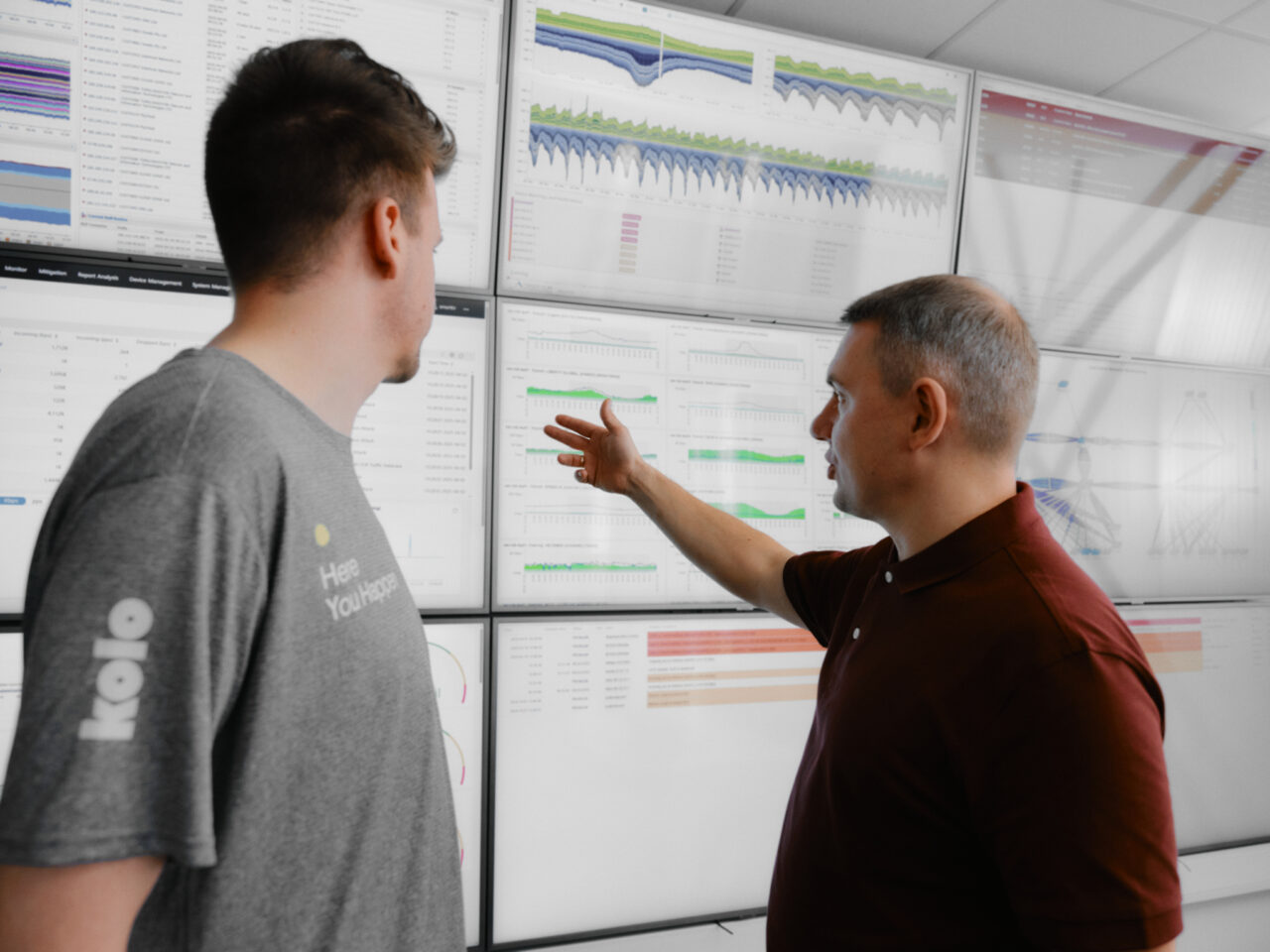Measuring AI’s footprint in real time
Kolo in pioneering collaboration with the University of Stuttgart
Text: Lisa Bjerre, IT Journalist
8 min read
- Whitepapers
- The Netherlands
- Public Sector & Government

- Whitepapers
- The Netherlands
- Public Sector & Government
The NADIKI-project
As AI workloads grow, so do their energy demands – yet most data centres lack transparency when it comes to power usage. In a pioneering research project, Kolo is working with the University of Stuttgart and SDIA to develop a new method for measuring the environmental footprint of AI.
The NADIKI research initiative was launched in 2023 with the aim of making AI’s environmental impact measurable, in real time at the infrastructure and IT level. Led by the University of Stuttgart and funded by the German government, the project brings together researchers and data centre operators to build a practical, open-source tool for tracking the actual energy and carbon impact of AI applications.
“Data centres today are like a black box. We aim to measure what’s happening inside that box”, says Professor Peter Radgen of the University of Stuttgart, a leading expert on energy efficiency in industrial and digital infrastructure.
“If you want to improve energy efficiency, you need to understand what is happening – not just input and output, but where the energy losses are occurring.”

From average to actual: Why NADIKI is different
AI workloads are among the most energy-intensive digital processes today. Yet, most existing carbon footprint estimation tools rely on static assumptions and generalised averages.
“They multiply standard assumptions with standard values,” explains Professor Radgen. “But that doesn’t give you the true picture.”
NADIKI was designed to track energy use dynamically. The system captures live consumption data, correlates it with real-time grid carbon intensity, and maps it to the specific workloads running at that moment.
“The carbon intensity of electricity changes throughout the day,” says Professor Radgen. “If you use an average value, you miss the difference between night and midday, between coal or gas and solar.”
By showing these variations clearly, NADIKI encourages smarter decisions such as shifting workloads to off-peak hours, favouring renewable-heavy periods, or targeting optimisation where it has the greatest effect.

Kolo’s involvement: turning research into application
Kolo was invited to join the NADIKI project in 2024 to help adapt the tool from academic concept to operational deployment. With a fast-expanding portfolio of data centres across multiple countries and infrastructure types, Kolo provides a highly varied testbed, ideal for developing a tool that must function across diverse real-world environments.
According to Professor Radgen, Kolo’s openness was critical:
“Kolo was the first to agree to provide real operational data. That was a big step. Together, we could move forward and integrate the system into Kolo’s live infrastructure.”
Yana Krasnova, Kolo’s AI and Environmental Strategy Lead, leads the technical collaboration, connecting the company’s infrastructure to the NADIKI system, identifying data gaps, and ensuring the tool delivers actionable results.
”Many in the AI space still focus only on performance, not on impact. Making the energy and emissions data visible is the first step towards changing that”, she says.
Why it matters – reporting and energy savings
The timing of the NADIKI initiative is no coincidence. The European Union’s Energy Efficiency Directive (EED) now requires data centres to report on a range of energy and emissions metrics. Clients, especially large corporations, are under growing pressure to meet science-based ESG targets, and are beginning to demand precise, verifiable data from their IT providers.
“Our clients already ask us for energy and renewables data. With this system, they’ll get it automatically — in real time, with full transparency”, says Yana Krasnova.
“Sustainability will become a key sales argument,” adds Professor Radgen. “If you can’t prove your efficiency or your carbon footprint, you will be left behind.”
Operational efficiency is another driver.
“Energy prices will not go down. If you can improve efficiency, you lower your cost base”, says Professor Radgen.
Live monitoring also helps operators identify inefficiencies in the systems. Kolo, for example, uncovered gaps in sensor coverage and opportunities to fine-tune cooling systems. This kind of internal visibility is just as valuable as external reporting.
”We now have a much clearer picture of our own infrastructure. It’s not just about reporting, it’s about improving how we operate”, says Yana Krasnova.
Challenges along the way
The lack of standardisation in data centres remains a major hurdle for measuring the footprint of AI applications.
“The data centre landscape is very heterogeneous. We had to build a structure that could adapt to all of them without losing clarity”, says Yana Krasnova.
“Every data centre has its own setup,” adds Professor Radgen. “For each site, you may need a different piece of code just to get the data out.”
While NADIKI is not a standard-setting body, its open-source framework could help steer the industry in that direction.
Another challenge is getting AI developers to participate. For many in the AI space, the idea of tracking the environmental footprint of a specific model is still relatively new.
“There’s still very little focus on impact in AI. We’re trying to change that by making the data impossible to ignore”, says Yana Krasnova.
“The focus is on performance and speed,” Radgen notes. “But when power usage becomes visible – when it has a number – it suddenly becomes part of the equation.”
“One of the longer-term goals is to extend accountability beyond runtime energy to embodied emissions – the carbon impact of hardware manufacturing, transport, and disposal. That data is missing today. But it’s needed if we want to understand the full impact.”
Looking Ahead
The current project phase runs until the end of 2025, with a follow-up already in planning to take the work further.
“Not every operator will use the tool exactly as we’ve built it,” says Professor Radgen. “But we’ll document it, publish the code, and share the KPIs. Larger operators might develop their own versions, and smaller ones can use ours.”
He believes that real-time tracking could eventually become a regulatory requirement across Europe.
“We already see movement in this direction. The Energy Efficiency Directive is just the beginning.”
In the future, Kolo’s clients will have the ability to time workloads for when the grid is cleaner.
”That means lower costs, a smaller footprint, and smarter infrastructure”, says Yana Krasnova.
Another major benefit will be automated environmental reporting.
“Our clients will have access to accurate, real-time data delivered directly from the data centre. It saves time, reduces manual errors, and helps them stay ahead of compliance demands”, she adds.
For now, NADIKI offers a glimpse of what’s possible: a system that provides visibility, drives accountability, and enables change – all in real time.
Text: Lisa Bjerre, IT Journalist
FACT BOX
What NADIKI measures
NADIKI is designed to monitor:
- Energy consumption at multiple levels (UPS, rack, server)
- Real-time carbon intensity of electricity used
- Cooling system efficiency
- Generator use and backup systems
- Embodied emissions from hardware (in development)
This data is then matched with the corresponding AI workloads. The system is designed to integrate with Kubernetes-based platforms and will be released as open-source software.
The project “Nachhaltigkeitsindikatoren für digitale Infrastruktur und KI-Anwendungen (NADIKI)” (Sustainability indicators for digital infrastructure and AI applications) is funded by the Federal Ministry of Research, Technology and Space.
https://www.z-u-g.org/foerderung/ki-leuchttuerme-fuer-umwelt-klima-natur-und-ressourcen/projekt/nadiki/